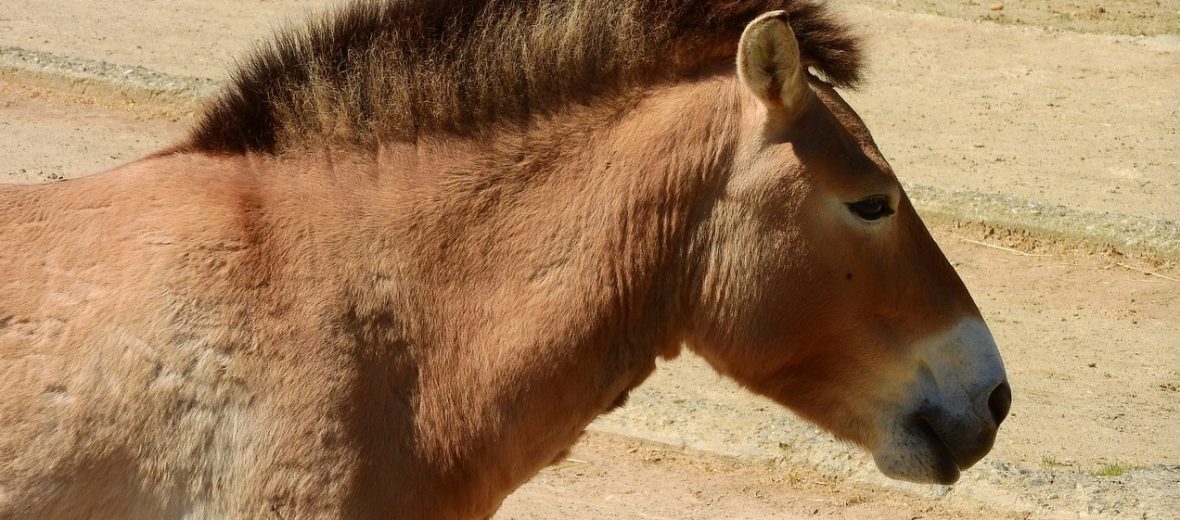
The Przewalski’s horse, aka Dzungarian horse, Mongolian wild horse, takh, or takhi, hails from Mongolia. More specifically Takhin Tal Nature Reserve, Khomiin Tal, and the Khustain Nuruu National Park. They prefer semi-desert habitats and steppes. Przewalski’s horses have been successfully re-introduced to Mongolia after going extinct in the wild, due to a successful reintroduction program. However, there are only an estimated 178 wild individuals currently. The rest remain in zoos or reintroduction programs. Those numbers are increasing though. They face the threats of habitat loss from mining; competition for food from livestock grazing; hunting; trapping; war; civil unrest; and climate change that brings about droughts, temperature extremes, and flooding. The IUCN lists these horses as Endangered.
First the Stats…
Scientific name: Equus ferus
Weight: Up to 800 lbs.
Length: Up to 8.5 feet
Height: Up to 5 feet, at the withers
Lifespan: Up to 25 years
Now on to the Facts!
1.) These horses are named after Nikolai Przewalski (pronounced “shuh-val-skee”), who was a Russian explorer. He was the first to discover the subspecies of this horse back in 1870.
2.) Przewalski’s horses are the only truly wild horse. Other domestic horses hail from Przewalski’s.
3.) They are diurnal (active during the day).
4.) Being gregarious, these horses dwell in small herds of up to 20 individuals.
5.) A group of horses is called a band, harras, herd, stable, stud, team, or troop.
But wait, there’s more on the Przewalski’s horse!
6.) They dwell in either bachelor or harem herds.
7.) Not only do they feed together, they also engage in mutual grooming.
Did you know…?
These horses can run up to 42.87 mph!
8.) Their diet consists of various plants and grasses. They will also take fruit, flowers, and even tree bark on occasions.
9.) These horses are polygynous (1 male mates with the mature females in his harem).
10.) Females undergo up to an 11 month gestation (pregnancy) that yields a single foal.
But wait, there’s still more on the Przewalski’s horse!
11.) Foals are weaned in up to 13 months.
12.) The foals, or colts, are able to stand and walk with their mother in just 1 hour after birth.
Did you know…?
Przewalski’s horses tend to shed their tail and mane at the same time, while domestic horses usually shed just a little bit at a time.
13.) Males are called stallions or studs. Females are called mares or dams. Young horses are called colts or foals.
14.) Przewalski’s horse populations are at risk due to interbreeding with domestic horses.
15.) They communicate primarily with a series of neighs that signal different things, such as greeting, general communication, and threat alerts.
But wait, there’s still a little more on the Przewalski’s horse!
16.) By the end of the 1950s, only a mere 13 individuals of this species remained in the wild. They were captured and protected, which afforded these horses a second chance at survival. Presently, the entire wild population of these horses the world over is comprised of the descendants of just these 13 horses.
17.) Przewalski’s horses symbolize the national heritage and culture of Mongolia.
18.) They have rather sharp hooves that are used to dig for water in dry river beds.
19.) Przewalski’s horses are considered to be the riding mounts of the gods and are thus called “takhi,” which translates to “holy” or “spirit.”
20.) In Spain and France, 30,000+ year old cave paintings depict sturdy horses that are believed to be Przewalski’s horses.
Now a Short Przewalski’s Horse Video!
Be sure to share & comment below! Also, check out the Critter Science YouTube channel. Videos added regularly!
Want to suggest a critter for me to write about? Let me know here.



